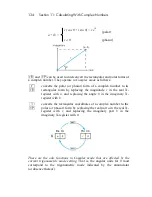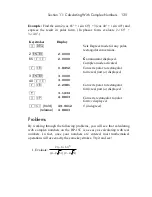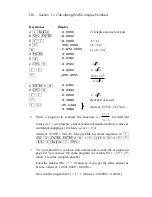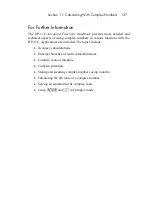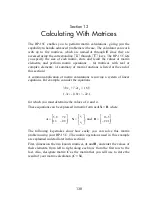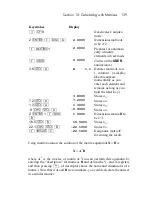
Section 12: Calculating with Matrices 141
Matrix inversion, for example, can be performed on an 8×8 matrix with real
elements (or on a 4×4 matrix with complex elements, as described later
*
).
To conserve memory, all matrices are initially dimensioned as 0×0. When a
matrix is dimensioned or redimensioned, the proper number of registers is
automatically allocated in memory. You may have to increase the number
of registers allocated to matrix memory before dimensioning a matrix or
before performing certain matrix
operations. Appendix C describes how
memory is organized, how to determine the number of registers currently
available for storing matrix elements, and how to increase or decrease that
number.
Dimensioning a Matrix
To dimension a matrix to have
y
rows and
x
columns, place those numbers
in the Y- and X-registers, respectively, and then execute
´
m
followed by the letter key specifying the matrix:
1.
Key the number of rows (
y
) into
the display, then press
v
to lift it into the Y-register.
Y
number of
rows
2.
Key the number of columns (
x
)
into the X-register.
X
number of
columns
3.
Press
´
m
followed by a
letter key,
A
through
E
,
that specifies the name of the
matrix.
†
*
The matrix functions described in this section operate on real matrices only. (In Complex mode, the
imaginary stack is ignored during matrix operation.) However, the HP-15C has four matrix functions that
enable you to calculate using real
representations
of complex matrices, as described on pages 160-173.
†
You don't need to press
´
before the letter key. (Refer to Abbreviated Key Sequences on page 78.)
Summary of Contents for HP-15C
Page 1: ...HP 15C Owner s Handbook HP Part Number 00015 90001 Edition 2 4 Sep 2011 ...
Page 17: ...Part l HP 15C Fundamentals ...
Page 64: ......
Page 65: ...Part ll HP 15C Programming ...
Page 118: ...118 ...








